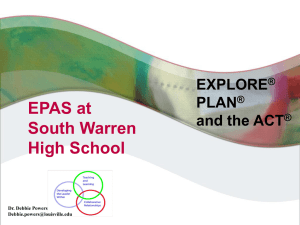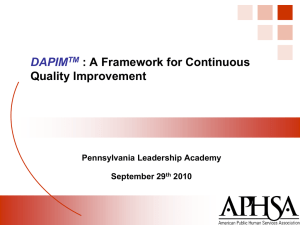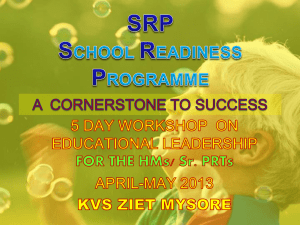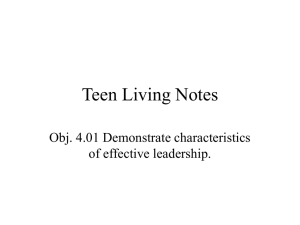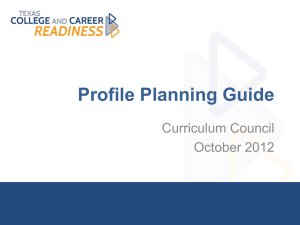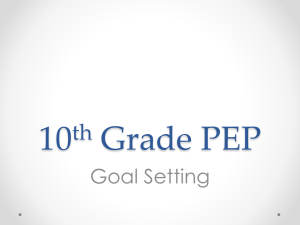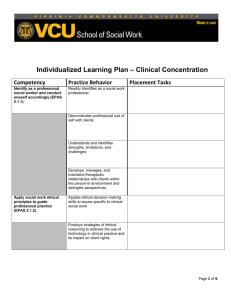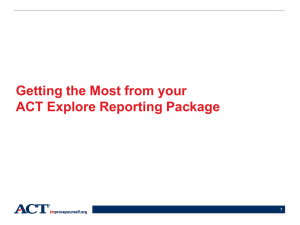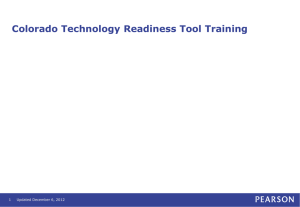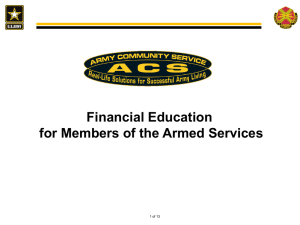ACT Explore Information Session PowerPoint
advertisement
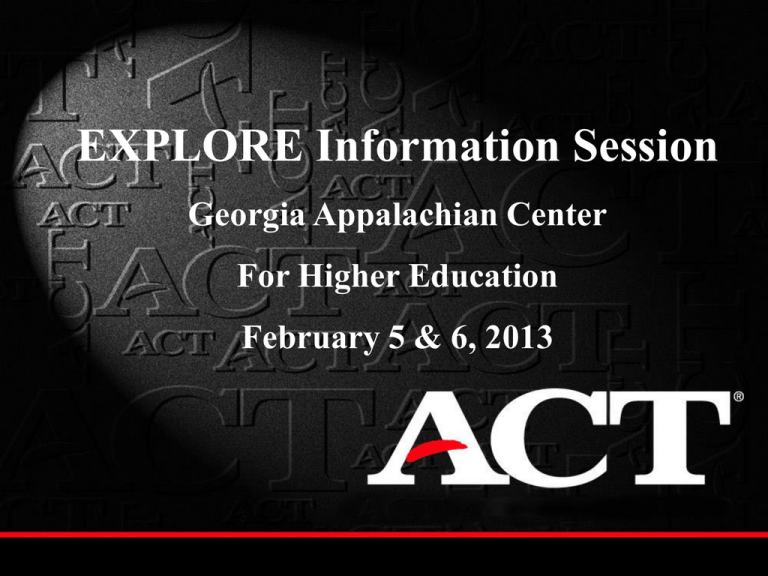
EXPLORE Information Session Georgia Appalachian Center For Higher Education February 5 & 6, 2013 Our ACT Consultant: Carl Forbes, MSED Senior Consultant East Region – Atlanta Office 404-231-1952 3355 Lenox Road NE, Suite 320 Atlanta, GA 30329 carl.forbes@act.org Topics/Agenda Assessment Overview Administration After The Test Questions College and Career Readiness System College and Career Readiness System MEASURING STUDENT PROGRESS TOWARD READINESS IMPROVING COURSE RIGOR EXPLORE PLAN The ACT ENGAGE QualityCore 8th and 9th grade curriculum-based educational and career planning program 10th grade curriculum-based educational and career planning program 11th and 12 grade curriculum-based assessment for learning outcomes Middle and high school assessment that measures all factors of academic success Research-driven solutions for strengthening curriculum SUPPORTING SOLUTIONS PLANNING SCHOOL IMPROVEMENT Core Practice Audit CoreWork Diagnostics Framework for evaluating current practices Online service to diagnose and improve content and practice areas EPAS - Educational Planning and Assessment System EXPLORE- 8th or 9th Assessment PLAN- 10th Student Planning ACT- 11th or 12th Instructional Support Evaluation EPAS Scales Relationship 40 35 30 25 20 15 10 5 0 32 36 25 EXPLORE PLAN ACT What Will EXPLORE Tell Us? Academic Progress Interests Career Plans at key transition points Educational Planning and Assessment System – EPAS CONTENT How are the test constructed? What do the tests measure? Guiding Principles of EPAS The EPAS tests are achievement tests. They are tests of acquired or developed abilities. The tasks (questions) constituting all EPAS tests correspond to recognized middle and high school learning experiences. The EPAS tests consists of complex, heterogeneous tasks that require students to use skills and knowledge developed over time to solve them. Each test is developmentally appropriate for the grade level English Test Designed to measure students’ ability to effectively communicate meaning by: Critiquing Revising Editing English Test 2 sub-scores EXPLORE Punctuation 6 (.15) 25 63% Usage/Mechanics Grammar and Usage 8 (.20) Sentence Structure 11 (.28) PLAN 7 (.14) 30 60% 9 (.18) 14 (.28) ACT 10 (.13) 40 (.16) 53% 12 18 (.24) Strategy Organization Rhetorical Skills Style 5 5 15 5 6 7 20 7 12 (.16) 11 (.15) 35 47% 12 (.16) Total 40 50 75 4 300 Words 4 300 Words 5 325 Words Passages Passage Length (.12) (.12) 37% (.12) (.12) (.14) 40% (.14) Mathematics Test Requires Students to Analyze problems – in both real world and purely mathematical settings Plan and carry out strategies Verify appropriateness of solutions Mathematics Test EXPLORE Content Area Basic Statistical/ Probability Concepts 4 (.13) Pre-Algebra 10 (.33) Elementary Algebra 9 (.30) Pre-Geometry 7 (.23) Plane Geometry Coordinate Geometry Intermediate Algebra Trigonometry Total 30 PLAN ACT 14 8 (.35) (.20) 14 10 (.23) (.17) 11 7 (.27) (.18) 14 9 9 4 (.23) (.15) (.15) (.07) 40 60 Reading Test Measures student proficiencies in understanding and deriving meaning from texts ranging from fiction narratives to informational passages Measures vocabulary by determining the meaning of unfamiliar or multiplemeaning words from context Measures skills used to read and understand published materials Reading Test Content Area Prose Fiction Humanities Social Sciences Natural Sciences EXPLORE 10 (.33) 10 (.33) 10 (.33) PLAN 8 (.32) 9 (.36) 8 (.32) ACT 10 (.25) 10 (.25) 10 (.25) 10 (.25) Total 30 25 40 Passages Passage Length 3 500 Words 3 500 Words 4 750 Words Reading Between the Lines Those ACT-tested students who can read complex texts are more likely to be ready for college Performance on complex texts is the clearest differentiator in reading between students who are likely to be ready for college and those who are not. And this is true for both genders, all racial/ethnic groups, and all annual family income levels Reading Between the Lines More students are on track to being ready for college-level reading in 8th & 9th grade than are actually ready by the time they reach 12th grade Not enough high school teachers are teaching reading skills or strategies and many students are victims of teachers’ low expectations Science Test Measures student proficiencies in using and reasoning with science information, skills, and knowledge Asks Students to: Communicate information and use scientific research strategies Make comparisons between, and draw conclusions from scientific findings, studies, and viewpoints Science Test - EXPLORE Content Area1 Format Life Science Physical Science Earth/Space Science Data Representation Research Summaries Conflicting Viewpoints 1Content areas are distributed over all formats Science Test Stimulus Material EXPLORE 12 (.43) Data Representation Research Summaries 10 (.36) Conflicting Viewpoints 6 (.21) PLAN 10 (.33) 14 (.47) 6 (.20) ACT 15 (.38) 18 (.45) 7 (.18) Total 30 40 28 Science Test - Passages Content Area Life Science Physical Science Earth/Space Science Biology Chemistry Physics Total EXPLORE 3 2 1 6 PLAN ACT 1-2* 1-2* 1-2* 1-2* 1-2* 1-2* 1-2* 1-2* 5 7 *At least one topic is required in this content area, and some test forms may have two topics. No more than two topics in a particular content area are allowed. MAKING READINESS A REALITY Monitor College Readiness Early Based on more than 540,000 8th graders who took EXPLORE in 2007: When students’ skills Majority of students not ACT data suggestsare that are improved during on target in middle students who enterschool high middle school, the to be ready for college-level school lacking prerequisite results by the end of workrarely after ever high catch schoolup skills high school can be astounding Non-Cognitive Components Student Information Section Name Student ID Number Birth Date Gender Current Grade Race / Ethnicity Non-Cognitive Components Needs Assessment Exploring options for Education, Careers, and jobs after HS Improving writing skills Improving reading speed or comprehension Improving study skills Improving mathematical skills Improving computer skills Improving public speaking skills Non-Cognitive Components Plans and Background Language the student knows best Types of courses planned in high school HS coursework plans in 5 subject areas Participation in accelerated, honors, or outreach programs Parents’ highest levels of education Educational and career plans after HS Non-Cognitive Components Local Supplemental Items What would you like to know about your students? + Average amount of time with TV, + Average amount of time spent studying + School environment + Teams? Non-Cognitive Components UNIACT Interest Inventory Included in all EPAS tests at no extra charge 72 item unisex interest inventory of work relevant activities Identifies personally relevant career options Bridged to World-Of Work Map and Holland Types World of Work Map E= Enterprising S=Social C=Conventional R=Realistic S A=Arts R I=Investigative World of Work Map Interest Inventory Results What We Need to Know to Help Students’ Scores Improve What skills the test measures How the test measures the skills How the test relates to my curriculum What skills my students already know What skills my students need to learn What instructional methods would be most effective in meeting the students’ needs . . . as a base for building instructional strategies Student Score Report Review Using Your EXPLORE Results Student/School Information What do Your Scores Mean? Score Range (1-25) Composite Score 15 Your Estimated PLAN Composite Score Range ACT Recommended Coursework ACT Minimum Core English: 4 years Social Sciences: At least 3 years Mathematics: At least 3 years Natural Sciences: At least 3 years Your High School Course Plans Compared to Core Your Reported Needs Your Plans for After High School College Readiness Benchmark Scores *The ACT Benchmark Score indicates a 50% chance of obtaining a “B” or a 75% chance of obtaining a “C” in corresponding credit-bearing college courses. College Readiness Benchmark Scores Explained College Readiness Career Area List Coursework Planning Page 10 Coursework Planner Page 12 EXPLORE Score Report Side 2 Building Your Skills www.explorestudent.org Additional Resources http://www.act.org/explore/downloads.html Supplemental Report Review EXPLORE Reports School Summary Profile Report Presentation Packet Early Intervention Roster Item-Response Summary Report College Readiness Standards Report Profile Summary Report This report provides an overall summary of information on all students who have taken the test in the district/school Includes option for 12 local items Page 2 EXPLORE (1 – 25) EXPLORE Subscores Page 3 Subscores Scale: EXPLORE 1-12 College Readiness Standards College Readiness Standards (CRS) are the statements that represent widely held learning goals that are important for success in high school, college, and the world of work. The CRS link EXPLORE, PLAN, and the ACT Assessment scores to curriculum and instructional decision making. I m p r o v i College Readiness Standards by Learning Strands and Score Ranges Basic Operations and . . . 16-19 20-23 Standards: Probability, Statistics, & Data . . . Standards: Numbers: Concepts & Properties Standards: Scores are seen as ideas for progress Assessment for Achievement, Standards: Standards: Standards: rather than Assessment of Achievement! ideas for progress EXPLORE CRS Tables Page 3 Educational Plans Page 5 EXPLORE Summary Profile Report Activity Presentation Packet Early Intervention Rosters Early Intervention Rosters Identify students who reported that they do not plan to complete high school, or have no post-high school educational plans Identify students who earned a composite score at or below the national 10th percentile (</= 10) Identify students who expressed a need for help in one or more areas Item-Response Summary Report College Readiness Standards Report Your School Curriculum Compared to EPAS For each skill, knowledge, or process: Is it included in your curriculum? At what grade level (or in which course) are students first introduced to the skill? At what grade level (or in which course) are students expected to demonstrate proficiency in this skill? Improving Academic Achievement College Readiness Guides Examples of test items by Strand by Score Range Suggestions for strategies and assessments by Strand Special Section: Using Assessment Information to Help Support Low-Scoring Students Connecting College Readiness Standards To The Classroom www.act.org/standard/guides/explore Building Success Strategies What is the data telling us? What are our College Readiness goals? What strategies need to be implemented this year? What are our long term strategies? What type professional development is needed? Our ACT Consultant: Carl Forbes, MSED Senior Consultant East Region – Atlanta Office 404-231-1952 3355 Lenox Road NE, Suite 320 Atlanta, GA 30329 carl.forbes@act.org

